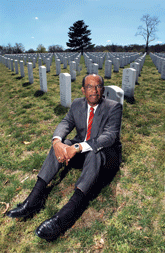Hallowed ground gets wired
Higginbotham brings Arlington National Cemetery into the 21st century
My goal is … so people can look up a grave from home and print
out a map that will show exactly where the grave site is.”
—Thurman Higginbotham
Thurman Higginbotham, deputy director of operations at Arlington National Cemetery, never misses an opportunity to pitch his vision for a fully automated information management system at ANC. Sometimes, it really pays off.
Two years ago, Higginbotham struck up a conversation with Sen. John Warner (R-Va.), who was attending a funeral at the cemetery. Warner, chairman of the Senate Armed Services Committee, happened to mention that he had received an e-mail from a constituent who expressed surprise at the lack of an automated records system when he went to the cemetery to find a relative’s grave site. The constituent had witnessed firsthand the cumbersome and time-consuming search through multiple sources to find the grave location.
“I said, ‘Oh boy, you’ve just opened the door for me.’ I gave [Warner] this whole spiel about what I wanted to do and how I wanted to do it,” Higginbotham said. “He said, ‘This place deserves just what you’re talking about.’ ”
Warner went back to Capitol Hill and got to work, sending staffers to Arlington to learn more about Higginbotham’s modernization plans. “He marked our budget up $5 million,” Higginbotham said. “When it got to conference it was reduced to $1.5 million. But that got us started.”
Today, Arlington National Cemetery is on the way to realizing Higginbotham’s vision. But getting there is a surprisingly complex and demanding undertaking.
For starters, managing ANC’s daily operations is enormously complicated. The cemetery conducts about 27 funerals a day. In addition to scheduling funerals and cemetery personnel to support each one, ANC must coordinate with the service branches to schedule the honors teams, chaplains and chapels.
Then there’s the task of managing ANC’s records. “ANC dates back to 1864, so the number of records that must be maintained is vast,” said ANC director John Metzler.
The cemetery has four separate sources for tracking, locating and identifying graves. There are about 350,000 grave cards listing occupants and details of their location in the ground, burial records including personal and family information, maps that identify graves by section and records for headstones.
On the scheduling front, ANC in 2003 rolled out a new, automated system for scheduling funerals, a marked improvement on a Veterans Affairs Department burial-scheduling system that ANC had been using since 1999. Before that, scheduling was done with “stubby pencils, telephones and a fax machine,” Metzler said.
Under Higginbotham’s plan, the scheduling system eventually will be merged into a total cemetery management system, in which all records will be digitized and integrated with a geographical information system.
To date, Higginbotham said, all the grave cards and burial records have been scanned and entered into a database. “Our next step is to validate the data using the grave cards, burial records, headstones and maps to make sure those four sources of data are synched up,” he said. He expects it to take about three years before the system goes live.
“We’ve just completed a business case with the Office of Management and Budget, which lays out the whole plan to develop the entire system after we’ve done some studies and looked at the most feasible way to do it,” Higginbotham said. “My goal is to have all the grave sites available online to the public, so people can look up a grave from home and print out a map that will show exactly where the grave site is.”
Higginbotham not only has had to sell his plans for modernizing the cemetery to OMB and to movers and shakers on the Hill, he’s had to convince skeptical fellow employees at ANC that it’s the way to go.
Higginbotham’s strategy is to make sure employees feel like players. “I always try to make them feel like they have ownership in it. We have meetings on the development of the program and I tell them, ‘You’re the ones who are sitting behind the computer every day, not me. I want your input as to how we can make it simpler and easier so you can do your job better.’ Then they sign on to it and feel like they’re part of it.”
Touting cemetery management modernization is nothing new for Higginbotham, who has worked for ANC for more than 41 years. He saw a need for technology decades ago.
In 1965, after a three-year stint in the Army, he took a job at ANC as a security guard. “They were hiring guards back then because there were so many visitors coming to the Kennedy grave,” he said. It was a way of getting his foot in the door in government service. A couple of years later, he became a cemetery representative, responsible for scheduling and accompanying funerals.
In the 1980s, Higginbotham became an administrative officer and began to research ways of transferring all the historic paper records to electronic format. He settled on microfiche, which is still used today to look up grave locations for visitors.
As desktop computers began to make their way into government offices, he saw that the possibilities for automating cemetery operations were endless. “I said to myself, ‘There’s no limit to what we could do with this.’ When I began doing some reading on GIS, I thought, ‘This is right down our alley.’ ”
That sort of prescience is what makes Higginbotham a visionary, Metzler said.
“And that’s not a word that should be tossed around lightly,” he added.
Michael Robert Patterson was born in Arlington and is the son of a former officer of the US Army. So it was no wonder that sooner or later his interests drew him to American history and especially to American military history. Many of his articles can be found on renowned portals like the New York Times, Washingtonpost or Wikipedia.
Reviewed by: Michael Howard

